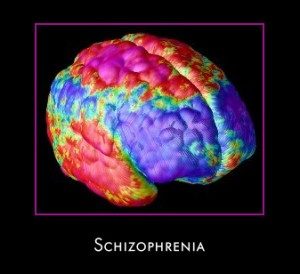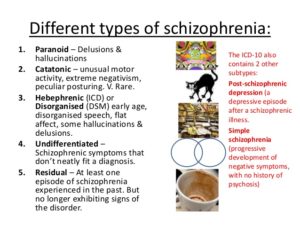Schizophrenia is a serious disorder which effects how a person thinks, feels and acts. A individual with this diagnosis may have difficulty distinguishing between what is real and what is imaginary; may be unresponsive or withdrawn; and may have difficulty expressing normal emotions in social situations. The person with schizophrenia may have difficulty expressing normal emotions in social situations.
Contrary to public perception, schizophrenia is not split personality or multiple ones. The vast majority of people with schizophrenia are not violent and do not pose a danger to others; if anyone they could put a danger to is themselves without supervision around. Schizophrenia is not caused by childhood experiences, poor parenting, lack of will power. The signs and symptoms of the disease are not the same for each person.
The cause of schizophrenia is still not clear.
Some theories about the cause of this disease include: genetics (heredity), biology (the imbalance in the brain’s chemistry); and/or possible viral infections and immune disorders.
One possible cause can be genetics (heredity). Scientists recognize that the disorder tends to run in families and a person inherits to develop the disease. Schizophrenia may also be triggered by environmental events like viral infections or highly stressful situations or a combination of both. Similar to some other genetically-related illnesses, schizophrenia appears when the body undergoes hormonal and physical changes, like those that occur during puberty in the teen and young adult years.
Another possible cause is Substance Use. Some studies have suggested that taking mind-altering drugs during teen years and young adulthood can increase the risk of schizophrenia. A growing body of evidence indicates that smoking marijuana increases the risk of psychotic incidents and the risk of ongoing psychotic experiences. The younger and more frequent the use, the greater the risk. Another study has found that smoking marijuana led to earlier onset of schizophrenia and often preceded the manifestation of the illness.
Another high possible cause deals with chemistry. Genetics help to determine huw the brain uses certain chemicals. People with schitzophrenia have a chemical imbalance of brain chemicals (serotonin and dopamine) which are neurotransmitters. These neurotransmitters allow nerve cells in the brain that send messages to each nerve cell. The brain is made up of nerve cells, called neurons, and chemicals, called neurotransmitters. An imbalance of one neurotransmitter, dopamine, is thought to cause the symptoms of schizophrenia. … The “dopamine hypothesis” has been the main theory regarding the cause of the symptoms of schizophrenia. Dopamine is produced in the dopaminergic neurons in the ventral tegmental area (VTA) of the midbrain, the substantia nigra pars compacta, and the arcuate nucleus of the hypothalamus. With the imbalance these chemicals affects the way a person’s brain reacts to stimuli—which explains why a person with schizophrenia may be overwhelmed by sensory information (Ex. loud music or bright lights) which other people can easily handle. This problem in processing different sounds, sights, smells and tastes can also lead to hallucinations or delusions.
Looking for a moment at Dopamine in different areas of the brain in both low and high amounts see how it effects brain thinking to better understand schizophrenia.
Dopamine in cognition:
Dopamine in the frontal lobes of the brain controls the flow of information from other areas of the brain. Disorders of dopamine in this region lead to decline in neurocognitive functions, especially memory, attention, and problem-solving.
D1 receptors and D4 receptors are responsible for the cognitive-enhancing effects of dopamine. Some of the antipsychotic medications used in conditions like schizophrenia act as dopamine antagonists. Older, so-called “typical” antipsychotics most commonly act on D2 receptors, while the atypical drugs also act on D1, D3 and D4 receptors.
Dopamine in movement
A part of the brain called the basal ganglia regulates movement. Basal ganglia in turn depend on a certain amount of dopamine to function at peak efficiency. The action of dopamine occurs via dopamine receptors, D1-5.
Dopamine reduces the influence of the indirect pathway, and increases the actions of the direct pathway within the basal ganglia. When there is a deficiency in dopamine in the brain, movements may become delayed and uncoordinated. On the flip side, if there is an excess of dopamine, the brain causes the body to make unnecessary movements, such as repetitive tics.
Dopamine in pleasure reward seeking behavior
Dopamine is the chemical that mediates pleasure in the brain. It is released during pleasurable situations and stimulates one to seek out the pleasurable activity or occupation. This means food, sex, and several drugs of abuse are also stimulants of dopamine release in the brain, particularly in areas such as the nucleus accumbens and prefrontal cortex.
Dopamine and addiction
Cocaine and amphetamines inhibit the re-uptake of dopamine. Cocaine is a dopamine transporter blocker that competitively inhibits dopamine uptake to increase the presence of dopamine.
Amphetamine increases the concentration of dopamine in the synaptic gap, but by a different mechanism. Amphetamines are similar in structure to dopamine, and so can enter the presynaptic neuron via its dopamine transporters. By entering, amphetamines force dopamine molecules out of their storage vesicles. By increasing presence of dopamine both these lead to increased pleasurable feelings and addiction.
Dopamine in memory
Levels of dopamine in the brain, especially the prefrontal cortex, help in improved working memory. However, this is a delicate balance and as levels increase or decrease to abnormal levels, memory suffers.
Dopamine in attention
Dopamine helps in focus and attention. Vision helps a dopamine response in the brain and this in turn helps one to focus and direct their attention. Dopamine may be responsible for determining what stays in the short term memory based on an imagined response to certain information. Reduced dopamine concentrations in the prefrontal cortex are thought to contribute to attention deficit disorder.
Dopamine is affected in schizophrenia, just look at the functions of the chemical and the signs and symptoms of schizophrenia.
Signs and symptoms of schizophrenia:
–Deficits in cognitive abilities are widely recognized as a core feature of this disease. The deficits impacting the cognitive function are found in a large number of areas: working memory, long-term memory,verbaldeclarative memory, semantic processing, episodic memory, attention, learning (particularly verbal learning). Deficits in verbal memory are the most pronounced in individuals with schizophrenia, and are not accounted for by deficit in attention. Verbal memory impairment has been linked to a decreased ability in individuals with schizophrenia to semantically encode (process information relating to meaning), which is cited as a cause for another known deficit in long-term memory. When given a list of words, healthy individuals remember positive words more frequently (known as the Pollyanna principle); however, individuals with schizophrenia tend to remember all words equally regardless of their connotations, suggesting that the experience of anhedonia impairs the semantic encoding of the words. These deficits have been found in individuals before the onset of the illness to some some extent and varying degrees.
-Delusions
-Hallucinations
-Disorganized speech
-Disorganized or catatonic behavior
TREATMENT FOR SCHIZOPHRENIA:
There is no cure for schizophrenia, but it can be treated and managed in several ways.
-Antipsychotic medications
-Psychotherapy, such as cognitive behavioral therapy and assertive community treatment and supportive therapy.
– Self-management strategies and education

